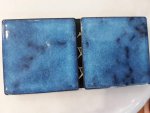- Jan 4, 2016
- 5,288
- Pool Size
- 44000
- Surface
- Plaster
- Chlorine
- Salt Water Generator
Welcome and Great job on all your planning!
+1 for SWG! Pays off for me and I'm retired too. I can't imagine lugging 6% bleach around, though also fair to say with TFPC indoors adult pool, your FC consumption is going to be miniscule. A SWG cell might last 10 or 15 years.
Nothing above is technically wrong, but 2" (50 mm) is fine throughout and it makes the work easier. With a VS pump, you will almost never run higher than mid-speed, and mostly on a low speed. In ten year's time you might decide to drain the pool, and the total electrical cost to do that will be less than what you spend on oddball stuff.
Sweep elbows don't improve anything other than appearance. Regular female by female 90s are fine and easier to measure when fitting. From the sounds of your ability and research to work it all out, I suggest you do all the plumbing yourself to be sure it's done well. Maybe let someone else do the digging and backfilling . Though by no means necessary, it's a great excuse to buy an electric chopsaw and then you'll have it for other stuff.
. Though by no means necessary, it's a great excuse to buy an electric chopsaw and then you'll have it for other stuff.
I'll steer out of locations and valves, cause I think your other helpers here are doing a great job! Very relieved to see the drawing with the skimmers valved at the pad. I wouldn't have a main drain myself.
I would plan for a suction cleaner, and I highly recommend the Pentair Rebel (Warrior). I like letting the filter do it's job rather than having something else to clean. I have yet to change the pump speed or run time to use it. It works fine on low, and if I have a surprise pool party, I put it on medium only if needed to get the vacuuming done quick. It's very simple inside and shows no wear after two seasons and running about 1/2 the total time the pump has run. I wish I had a vacuum port just below the water line in the pool, with the self-closing safety flap, but it has worked fine plugged into the skimmer. I would absolutely not use a pressure cleaner. Being indoors, the cleaner will probably spend more time out of the pool, so a robot sitting on a caddy is less total stuff getting in the way, which might be a consideration, and a robot does some of the brushing which is nice. A suction cleaner left in the pool doesn't look bad the way a robot does because the hose doesn't tangle. (fair warning: you'll get lots of opinions on this one!)
That's going to be an amazing place. Congrats on retiring and taking on the big project!
+1 for SWG! Pays off for me and I'm retired too. I can't imagine lugging 6% bleach around, though also fair to say with TFPC indoors adult pool, your FC consumption is going to be miniscule. A SWG cell might last 10 or 15 years.
Nothing above is technically wrong, but 2" (50 mm) is fine throughout and it makes the work easier. With a VS pump, you will almost never run higher than mid-speed, and mostly on a low speed. In ten year's time you might decide to drain the pool, and the total electrical cost to do that will be less than what you spend on oddball stuff.
Sweep elbows don't improve anything other than appearance. Regular female by female 90s are fine and easier to measure when fitting. From the sounds of your ability and research to work it all out, I suggest you do all the plumbing yourself to be sure it's done well. Maybe let someone else do the digging and backfilling
I'll steer out of locations and valves, cause I think your other helpers here are doing a great job! Very relieved to see the drawing with the skimmers valved at the pad. I wouldn't have a main drain myself.
I would plan for a suction cleaner, and I highly recommend the Pentair Rebel (Warrior). I like letting the filter do it's job rather than having something else to clean. I have yet to change the pump speed or run time to use it. It works fine on low, and if I have a surprise pool party, I put it on medium only if needed to get the vacuuming done quick. It's very simple inside and shows no wear after two seasons and running about 1/2 the total time the pump has run. I wish I had a vacuum port just below the water line in the pool, with the self-closing safety flap, but it has worked fine plugged into the skimmer. I would absolutely not use a pressure cleaner. Being indoors, the cleaner will probably spend more time out of the pool, so a robot sitting on a caddy is less total stuff getting in the way, which might be a consideration, and a robot does some of the brushing which is nice. A suction cleaner left in the pool doesn't look bad the way a robot does because the hose doesn't tangle. (fair warning: you'll get lots of opinions on this one!)
That's going to be an amazing place. Congrats on retiring and taking on the big project!


